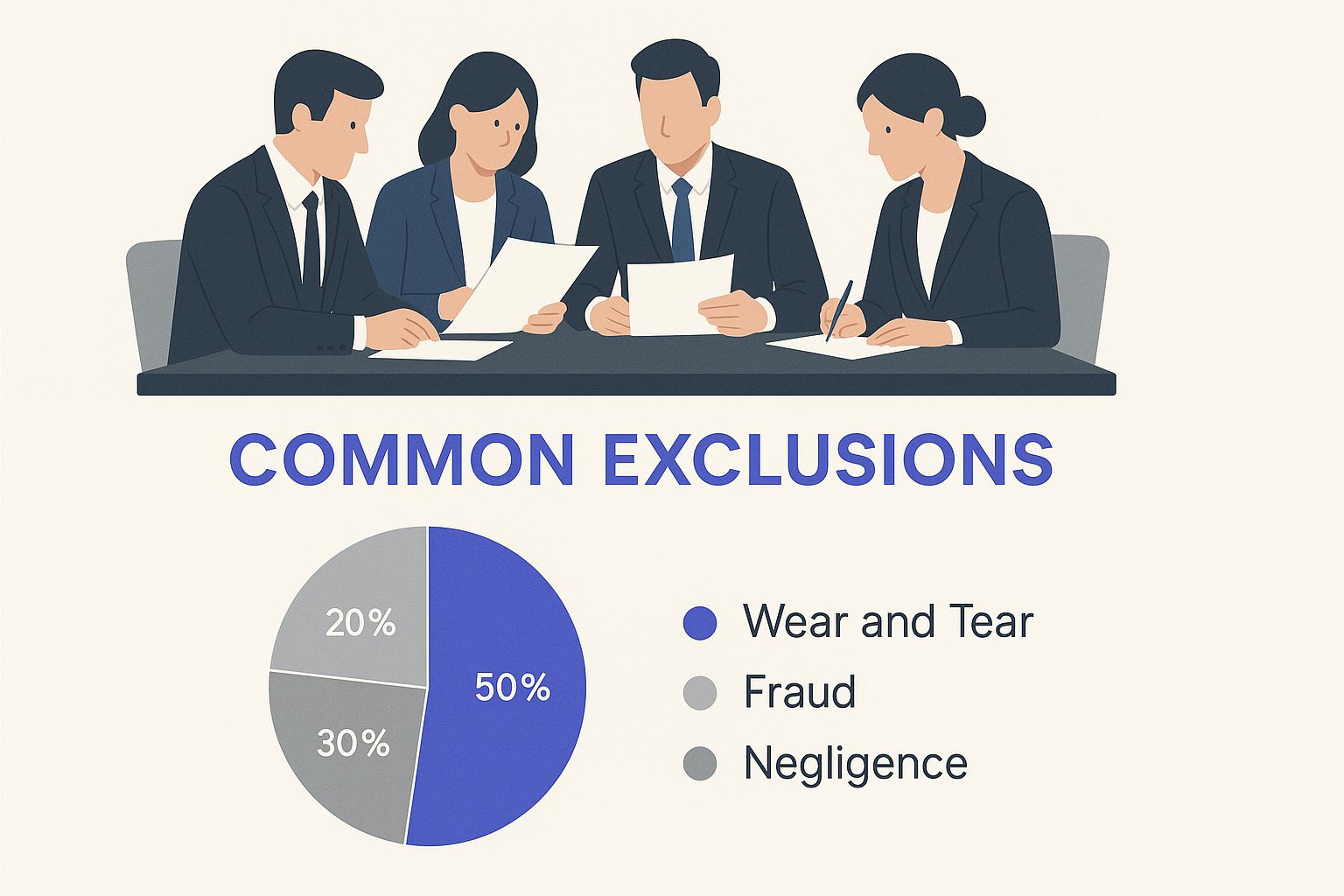
A limitation of liability clause is a contractual provision that puts a financial ceiling on the damages one party can claim from the other if things go sideways. Think of it as a pre-negotiated financial safety net. It’s designed to make sure a single mistake doesn’t mushroom into a catastrophic, business-ending disaster by turning unpredictable risks into manageable, defined figures.
What Is a Limitation of Liability Clause?

Let's say you hire a contractor to build a small deck for $5,000. While working, they accidentally hit a hidden water pipe, causing $50,000 in water damage to your home. Who’s on the hook for that? Without a limitation of liability clause, that contractor could be liable for ten times the value of their entire project.
This is exactly where the clause comes into play. It's a tool for risk allocation, not risk elimination. It helps both parties agree on a sensible limit to potential damages before any work even starts. This creates predictability and encourages companies to take on projects without being paralyzed by the fear of disproportionate financial fallout.
Key Functions of a Limitation of Liability Clause
At its core, the clause is all about creating a predictable financial landscape. It establishes clear boundaries that allow businesses to operate with a lot more certainty.
This table breaks down the essential jobs a limitation of liability clause performs for your business.
| Function | What It Does for Your Business |
|---|---|
| Risk Management | Quantifies your potential financial exposure, turning unknown, scary risks into known, manageable figures. |
| Cost Control | Helps you price your services more accurately by capping liability, so you don't have to bake in worst-case-scenario costs. |
| Encouraging Commerce | Protects smaller businesses from disproportionately huge claims, allowing them to confidently engage in larger projects. |
By managing risk and setting clear expectations, these clauses allow both parties to move forward with confidence.
In short, a limitation of liability clause ensures the potential penalty for a mistake is proportional to the value of the deal, not infinitely greater. It's a real cornerstone of modern contract law.
This provision is a fundamental piece of the puzzle in contract negotiations. For a deeper look into the broader legal context where these clauses fit, it's worth exploring additional legal resources. Understanding its role is key to protecting your business interests effectively.
Why Capping Your Liability Is Essential for Business
Imagine you've just wrapped up a $5,000 project. Everything seems great, but then an unforeseen error leads to a lawsuit. Without a cap on your liability, that $5,000 job could snowball into a $500,000 legal nightmare. That kind of disproportionate risk can paralyze a business, making even smart, calculated risks feel terrifying.
This is where a limitation of liability clause comes in. Its core purpose is to swap that scary, unknown financial exposure for a clear, manageable number. It draws a line in the sand, setting a maximum financial ceiling for what you could owe if things go wrong. This isn't just about damage control; it's a bedrock principle of smart business planning.
When potential losses are capped, both you and your client can price services more accurately and operate with a lot more financial stability. It builds trust and makes it easier to work together, knowing that the fallout from a mistake will stay proportional to the contract's value.
Creating a Predictable Risk Environment
Commerce thrives on predictability. The idea of limiting liability isn't some new legal trick; it has deep historical roots designed to encourage economic growth by taking catastrophic risk off the table.
Look at the maritime industry, for example. The U.S. Limitation of Liability Act of 1851 lets shipowners limit their liability to the value of their vessel after an accident. This law was created to shield them from financial ruin over events that were often completely out of their control, striking a balance between protecting the carrier and compensating claimants.
That same principle applies across every industry today. It allows companies to innovate and take on new challenges without being haunted by the fear that one single mishap could wipe them out.
By defining the financial boundaries from the outset, a limitation of liability clause allows businesses to focus on performance and growth rather than on fearing worst-case scenarios that could bankrupt them.
Protecting Your Assets and Ensuring Longevity
At the end of the day, capping your liability is about survival. It’s a strategic move that complements other protective measures you take for your business. For instance, a crucial part of managing risk is choosing the right legal entity to limit liability, which creates a barrier between your personal assets and business debts.
These clauses also work hand-in-hand with other contractual tools. A great example is the indemnification clause, which manages claims from third parties. You can learn more about that in our guide: https://legaldocumentsimplifier.com/blog/what-is-indemnification-clause. When used together, these legal elements build a strong framework that protects your operations, your assets, and your ability to stay in business for the long haul.
Common Types of Liability Caps in Contracts
When you hear "limitation of liability," don't picture a single, rigid rule. It’s more like a toolkit, with different instruments designed for different situations. Getting familiar with these common structures is the first step to negotiating a clause that fairly balances risk for everyone involved.
The most straightforward tool is the fixed monetary cap. This sets a hard dollar amount—say, $1 million—as the absolute ceiling for liability, no matter how big the contract is or how much damage was actually done. It offers predictability, which is great, but it can feel a little random if it's not connected to the project's actual value.
Another popular approach ties the cap directly to the contract's value. This could mean the maximum liability is equal to the total price of the agreement, or maybe a multiple of it. For ongoing services, you'll often see liability limited to the fees paid over a specific period, like the previous 6 or 12 months.
Excluding Specific Types of Damages
Beyond just capping the total payout, many clauses will also carve out and exclude certain types of damages. This is often just as important as the dollar amount itself. The goal here is to prevent liability from spiraling out of control due to indirect or unforeseeable losses.
Commonly excluded damages you’ll run into include:
- Consequential Damages: Think of these as knock-on effects. For example, if faulty software causes a factory to shut down, the lost production is a consequential damage.
- Lost Profits: If a service outage means your client misses out on sales, this exclusion stops them from claiming that lost revenue from you.
- Punitive Damages: These are designed to punish a party for bad behavior rather than just compensate for a loss, and they are almost always excluded from liability.
This image breaks down some of the most common exclusions you'll see discussed when hammering out these clauses.

As you can see, the whole point is to shield a business from those unpredictable, cascading financial hits that go way beyond the direct scope of the contract. Nailing this down is a huge part of tackling the https://legaldocomentsimplifier.com/blog/top-7-contract-management-challenges-in-2025 that businesses are up against.
To round out your risk strategy, it's also smart to look at how your insurance coverage works with these contractual limits. Taking some time for understanding the nuances of professional liability versus general liability insurance can make a massive difference.
To make this even clearer, let's compare the most common liability caps you'll find in the wild.
Comparing Common Liability Caps
| Type of Cap | How It Works | Common Use Case |
|---|---|---|
| Fixed Dollar Amount | A specific, predetermined monetary limit (e.g., $1 million). | High-value projects where predictability is paramount for both parties. |
| Contract Value | The cap is set to the total fees paid under the agreement. | One-off projects or sales of goods where the value is clearly defined. |
| Fees Paid Over Time | Liability is limited to fees paid during a set period (e.g., the last 12 months). | Subscription services, SaaS platforms, and other ongoing retainers. |
| Insurance Coverage | The cap is tied to the amount of available insurance coverage. | Service agreements where insurance is the primary backstop for potential claims. |
Each of these methods has its place, and the best choice really depends on the nature of the work, the relationship between the parties, and the overall risk involved. Choosing the right structure is key to crafting a fair and effective limitation of liability clause.
How Poor Wording Can Make Your Clause Useless
A limitation of liability clause is only as good as the words you use to write it. Vague, fuzzy language creates loopholes that can make your protections totally worthless right when you need them.
Think of it like a safety harness with a frayed rope. It looks like it will protect you, but it’s guaranteed to fail under pressure.
The details are everything. Tiny distinctions in phrasing can have massive financial consequences, and a common tripwire is failing to clearly define the scope of the liability cap. This is where so many businesses get into trouble.
For instance, does your contract limit liability on a “per claim” basis or as an “aggregate” total for the entire project? The difference is huge. A $50,000 “per claim” cap could force you to pay out $50,000 multiple times if several different issues pop up. An “aggregate” cap, on the other hand, means $50,000 is the absolute most you’d ever have to pay, no matter how many things go wrong.
The Importance of Precision
This isn't just a "what if" scenario; courts dissect this exact language all the time. If a clause is unclear, judges often interpret it in the way that’s least favorable to the person who wrote it.
A poorly worded clause creates uncertainty, and in legal disputes, uncertainty is expensive. The goal is to leave zero room for interpretation by being explicit about what is covered and how the cap is applied.
Recent court decisions hammer this point home. A 2023 English High Court case, for example, stressed that contracts must use crystal-clear language to define whether a liability cap applies per incident or as a single overall limit. The ruling confirms that any ambiguity will be interpreted narrowly unless the contract spells it out. You can dive deeper into how courts are tackling this and discover insights on liability limitation drafting on DLA Piper.
Ultimately, investing a little extra time in precise wording upfront ensures the protection you think you have is the protection you actually get.
What a Liability Clause Will Not Protect You From

While a limitation of liability clause is a powerful financial shield, it's not made of vibranium. It has cracks, and courts are quick to exploit them when public policy is at stake. Think of it as a legal protection with some built-in exceptions, or "carve-outs," that ensure a fundamental level of accountability is always maintained.
Understanding these boundaries is just as crucial as knowing what the clause covers. It helps you avoid a false sense of total immunity and gives you a realistic picture of your remaining legal exposure. No matter how perfectly you draft it, a contract simply cannot shield you from everything.
Unenforceable Actions and Behaviors
Certain behaviors are so fundamentally unfair that the law refuses to let anyone contract their way out of the consequences. If you try to use a liability clause to protect yourself from these actions, a judge will likely throw it out.
Here are the big ones where liability caps almost always fail:
- Deliberate Fraud or Deceit: You can't lie to or intentionally mislead someone and then hide behind a contract clause to escape the fallout.
- Willful Misconduct: This is when you intentionally do something you know is wrong or will probably cause harm.
- Gross Negligence: This isn't just a simple mistake. It's a reckless, shocking disregard for the safety or rights of others.
The principle here is simple: the law isn't going to help you enforce a contract that protects you from your own intentional wrongdoing.
This idea is closely related to an exculpatory clause, which also has its limits. If you want to dive deeper, our guide explaining what an exculpatory clause is covers these boundaries in more detail.
On top of that, liability caps often won't protect you from breaching core duties of the contract itself, like breaking a confidentiality agreement or stealing intellectual property.
A Few Common Questions About Liability Clauses
Even after you get the hang of what a limitation of liability clause does, some practical questions always seem to pop up. Here are some straight-up answers to the things business owners ask most, which should clear up how these clauses work in the real world.
Are Limitation of Liability Clauses Always Enforceable?
Nope, not always. Whether a court will enforce one comes down to a few things, like the laws in your state, how clearly the clause is written, and what kind of claim is being made.
Courts can—and do—throw out clauses they consider "unconscionable," which is a legal way of saying they're just plain unfair or ridiculously one-sided. A clause is also likely to get tossed if it's vague or tries to let someone off the hook for things like intentional harm, fraud, or gross negligence. The power dynamic between the two parties matters, too; a clause that a massive corporation shoves in front of a small business might get a closer look.
Bottom line: To give your clause the best chance of holding up, it needs to be crystal clear and reasonable.
What's the Difference Between a Liability Cap and an Indemnity Clause?
Great question. Both of these clauses deal with risk, but they tackle it from different angles and you'll often see them working together in the same contract.
- Limitation of Liability: Think of this as a defensive shield. It puts a ceiling on the total amount of money one party can get from the other within the contract. It’s all about limiting your direct financial exposure to your client.
- Indemnity Clause: This one is a protective tool. It’s about making one party cover the other's legal costs if a third party sues. For example, if your client gets sued by one of their customers because of work you did, an indemnity clause could mean you’re on the hook for their legal bills.
In a nutshell, a liability cap protects you from the person you have a contract with. An indemnity clause protects you from everyone else who might have been affected by the work you did under that contract. They handle two totally different kinds of financial risk.
How Do I Negotiate a Reasonable Liability Cap?
A good negotiation here is all about finding a fair balance between risk and reward. The idea is to land on a number that everyone can agree on, one that makes sense given the value of the deal and what could realistically go wrong.
A common and totally reasonable place to start is tying the liability cap directly to the value of the contract itself, like the total fees you've been paid or will be paid. When you're at the negotiating table, be ready to explain why the cap you're suggesting is a fair way to split the risk for the services you're providing.
Clear communication is your best friend here. Be specific about what the cap covers and what it doesn't. For bigger, more complex projects, being upfront about the risks helps build trust and usually leads to an agreement that works for both sides. And if you're ever in doubt, talking to a lawyer is a smart move to make sure you're properly protected.
Trying to make sense of limitation of liability clauses and other dense contract terms doesn't have to be a headache. Legal Document Simplifier uses AI to instantly translate complex legal text into simple, actionable summaries. Just upload your contracts and let our platform point out the key terms, risks, and obligations so you can make decisions with total confidence. Simplify your legal documents today.